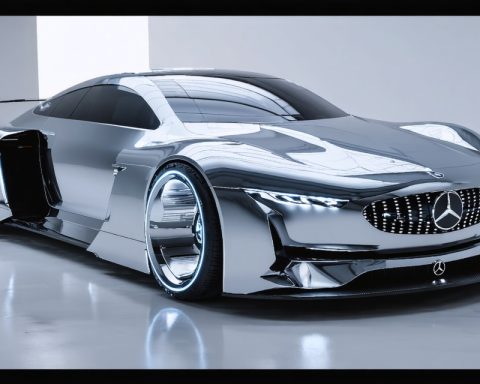- The EU and China are considering a minimum price agreement for Chinese EVs sold in Europe, potentially replacing high tariffs.
- China has emerged as a leading force in the global EV market, surpassing Japan as the top automobile exporter.
- The EU aimed to impose tariffs to protect its developing EV industry from intense Chinese competition.
- A pricing agreement could maintain market balance in Europe, while securing reasonable margins for Chinese exporters.
- Sino-European cooperation is growing, with partnerships fostering shared advancements in automotive technology.
- Chinese manufacturers are strategically managing European market pricing to offset costs and enhance brand value.
- The collaboration signals a move toward sustainable, globally-minded automotive policies between the EU and China.
- Cooperation is seen as a pathway to a resilient global automotive ecosystem, prioritizing mutual progress over confrontation.
Balancing on a tightrope of economic diplomacy, the European Union and China stand ready to reshape the contours of the global electric vehicle (EV) industry. Since late last year, the EU had adopted a stiff posture, gearing up to slap substantial tariffs on Chinese electric cars—to the tune of 45.3% for some producers—skeptics worried that this could throttle market access and stifle competition. Yet now, a surprising pivot is underway: the two giants are contemplating a more pliable alternative—a mutual agreement on setting a minimum price for Chinese EVs sold in Europe.
The backdrop to this maneuver is the rapid ascent of China as a global paragon in the electric vehicle realm. Boasting 11 out of the top 20 global EV manufacturers, China has elbowed its way past Japan to become the foremost automobile exporter worldwide. Its domestic strengths—low production costs and robust supply chains—afford its EV manufacturers a competitive edge that Europe finds hard to match, especially as it tentatively embraces electric mobility.
The EU’s initial plans to impose high tariffs emerged as a defense mechanism, hoping to shield its nascent electric initiatives from overwhelming Chinese competition. Industry analysts predicted a stark drop in sales figures for Chinese stalwarts like SAIC and BYD had these tariffs been executed. On the ground, however, a pricing agreement introduces a different dynamic—a cooler strategic calculation replacing the sledgehammer of trade barriers.
Setting a minimum price, while voluntary—and perhaps paradoxical in a free-market sense—addresses a dual necessity. It preserves market equilibrium in Europe, ensuring that consumers are not dazzled away en masse by cheaper imports, while simultaneously maintaining viable margins for Chinese exporters. Industry experts note that this decision could protect European producers from being undercut, fostering a semblance of fair play.
Beyond shifting trade policies, a broader trend materializes: Sino-European cooperation flowering amidst automotive innovation. Europe—still in the preliminary phases of its electrification journey—finds itself intertwined with its Chinese counterpart. Partnerships between firms like Volkswagen and Xpeng, or Leapmotor and Stellantis, highlight a growing acknowledgment of mutual reliance. Knowledge transfer and joint developments blur national lines in the race for electric dominance.
However, not all is seamless in this diplomatic ballet. Chinese manufacturers are noticeably addressing the variable pricing across markets with strategic finesse. Vehicles sold in Europe emerge at premiums compared to domestic labels, a move both to cover inherent costs like taxes and logistics and to elevate brand prestige.
The essence of these developments isn’t merely a negotiation on tariffs or prices but a discussion about the future—the pursuit of sustainable policies that honor the international nature of today’s automotive industry. Dismantling barriers while fostering competitive viability remains the linchpin of redrawing this sector’s frontier.
As this new chapter unfolds, it reinforces a singular truth: The global EV market is not merely about selling cars but about philosophical shifts in economic policy and environmental stewardship. Both Europe and China appear to recognize that their chosen path of collaboration could pave the way to a more cohesive and resilient global automotive ecosystem.
In the intricate dance of diplomacy and commerce, each partner must find its footing. By harmonizing their steps, the EU and China inch closer to an electrifying future—one where cooperation, not confrontation, defines progress.
How Europe’s New Deal with China Could Transform the Global EV Market
The Strategic Shift in EU-China Electric Vehicle Relations
The EU’s recent shift towards negotiating a minimum price for Chinese electric vehicles (EVs) sold in Europe marks a significant change in strategy. Initially, the EU had planned to impose steep tariffs on these vehicles, fearing that China’s expansive reach in the EV sector could dwarf European initiatives. With the possibility of setting a minimum price, the focus is now on fostering a competitive yet cooperative market that could benefit both regions.
How-to: Steps for Implementing a Minimum Price Agreement
1. Establish Transparent Criteria: Develop clear guidelines on how the minimum price will be set and enforced.
2. Involve Stakeholders: Consult major industry players from both regions to ensure collaborative buy-in and alignment.
3. Monitor the Market: Continuously assess the impact of the pricing strategy on both local and international markets.
4. Adapt and Adjust: Be prepared to modify the agreement based on market dynamics and trade conditions.
Real-World Implications of the Agreement
Market Forecasts & Industry Trends
– Sustained Growth: Experts predict a stabilization in the European EV market as the pricing agreement prevents market saturation by cheap imports.
– Joint Ventures: Collaborative projects like Volkswagen with Xpeng and Stellantis with Leapmotor are expected to multiply, leveraging the strengths of both regions.
– Innovation Surge: Knowledge sharing could lead to rapid advancements in EV technologies.
Reviews & Comparisons
– Consumer Perspectives: European consumers may face higher initial purchase prices but can expect improved quality and innovation.
– Brand Strategies: Chinese brands like NIO and Geely might position themselves as premium options in Europe to create added value beyond just pricing.
Controversies & Limitations
The voluntary nature of the minimum price agreement may spark debates. While it avoids the rigidity of tariffs, it raises questions about free-market principles. There’s the risk of creating an artificial price ceiling that could inadvertently stifle innovation or market entry for smaller players.
Key Features and Possible Security Concerns
– Quality Assurance: European markets can expect higher-quality imports as Chinese manufacturers focus on brand prestige and compliance with EU standards.
– Data Security: With increased connectivity in EVs, data protection becomes paramount. Both regions must agree on stringent data privacy regulations.
Future Insights & Predictions
Economic analysts suggest that this agreement could serve as a blueprint for other industries facing similar competitive pressures. Appealing to shared objectives—like reducing carbon footprints and promoting sustainable technologies—could enhance cooperation on a global scale.
Pros and Cons Overview
Pros:
– Avoids trade wars and promotes economic diplomacy.
– Encourages innovation through strategic partnerships.
– Protects domestic industries while integrating new players.
Cons:
– May be perceived as market manipulation.
– Could reduce short-term price competition favoring consumers.
– Implementation and monitoring require extensive cooperation.
Actionable Recommendations
1. Stay Informed: European consumers should monitor developments in pricing and technology to make informed purchasing decisions.
2. Explore Incentives: Investigate available government incentives for purchasing more expensive yet advanced EV models.
3. Advocate for Sustainability: Support policies that prioritize environmental benefits alongside economic gains.
For more about the EU’s economic policies and industry dynamics, visit the official European Union’s website. For insights on China’s automotive industry, consult the official National Development and Reform Commission of China.
In summary, this evolving arrangement between the EU and China is more than a mere business decision; it’s a step towards redefining the global EV industry for a sustainable future.












